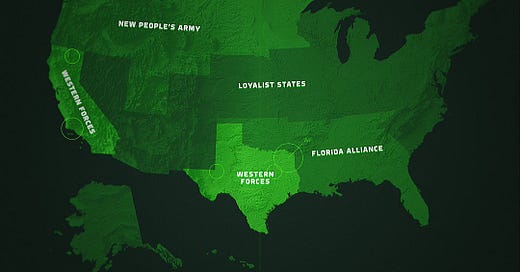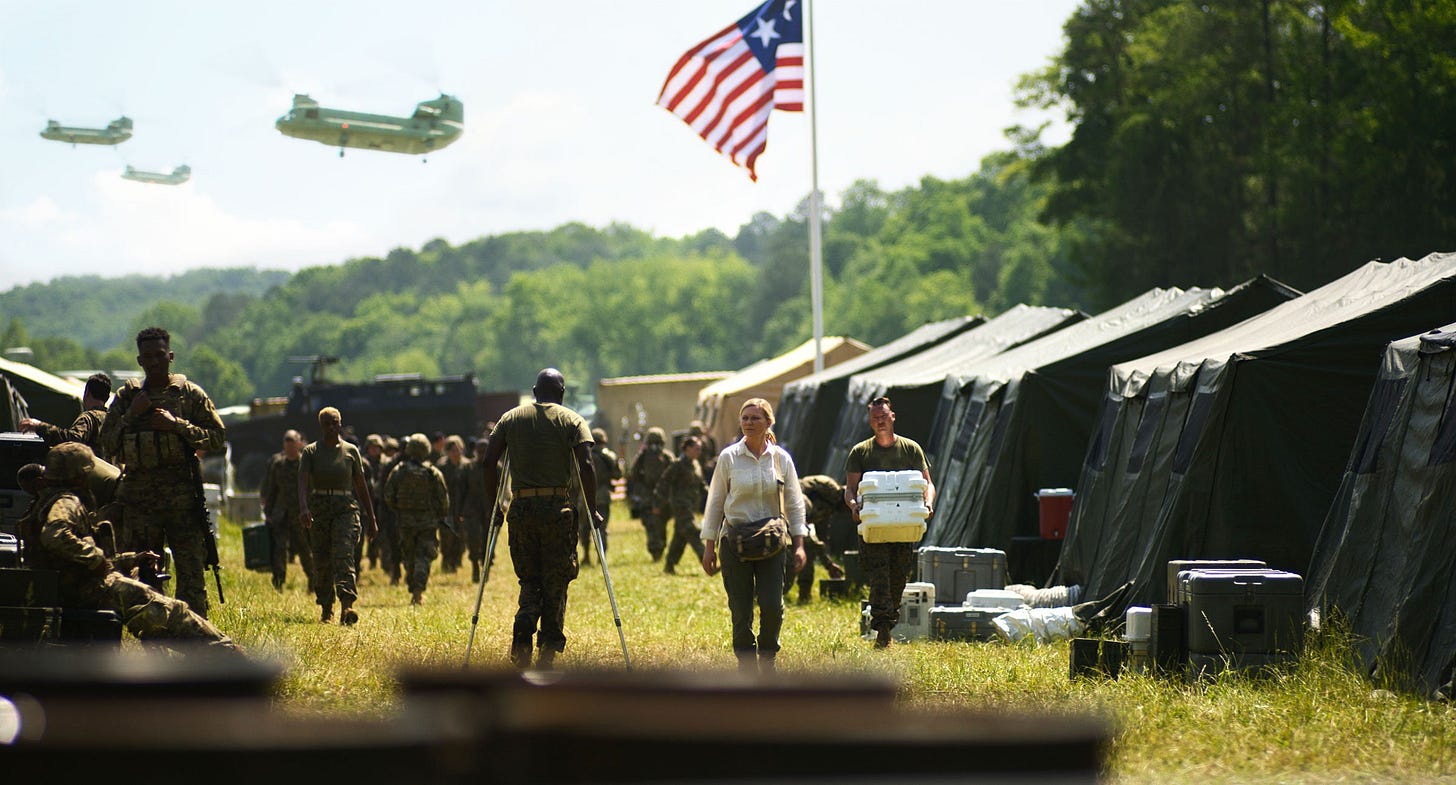Mrs. Woe and I went to see Alex Garland’s Civil War last Sunday evening.1 It’s worth seeing, and if you’re going to see the movie, see it on the big screen at a good theater. We saw it with Dolby Cinema and it was a powerful experience. Our seats vibrated with every gun shot, every helicopter, every explosion. Neither of us had experienced such a visceral war movie since Saving Private Ryan.
Warning: The remainder of this essay will contain spoilers for the movie.
After finishing Civil War, my wife and I discussed its politics. Both of us agreed that Garland had done such a good job of making the movie sufficiently opaque that an average American of either Blue or Red persuasion could enjoy it. Most people would, we felt, look no deeper than the superficial message: “civil war bad.”
But we also both concluded it was, at its core, a left-wing movie. “Given the movie’s left-wing sentiments, the progressive critics must have loved it,” I thought. “Let’s see what they have to say!”
So I opened up Wired.com to read its review, entitled
The Troubling Politics of Alex Garland’s Civil War:
When director Alex Garland sat down in 2020 to write his new movie, Civil War, he was clearly worried about the polarization of American society. The Covid-19 pandemic was just beginning to take hold, and former US president Donald Trump was still in the White House. It was a much different country from the one in which Garland is releasing his biggest film to date.
Garland [has] created… a far-right fantasy recruiting tool. In Civil War, Garland’s apocalyptic US features a country ostensibly stripped of partisan labels, where both the left and right become intolerant of each other and turn deadly…
Garland’s argument that both sides are at fault… is disingenuous to the reality of the United States. There is only one side calling for a “civil war.” There is only one side stoking hatred by spreading conspiracy theories about the Great Replacement. There is only one side boosting baseless and widely debunked theories that elections are rigged. There is only one side whose presidential candidate is promising a “bloodbath” if he loses the election.
Foolish me. Even when a left-leaning director makes a movie with subtle left-wing themes, the Left still can’t stomach it. It has to literally be far-left propaganda or its “troubling” and “problematic.”
Now, I am a difficult man to anger, and I cannot say that Wired’s review actually angers me. But it irks me. It peeves me. It’s… moronic. I need to escape this clown world. Because Wired is wrong; Civil War is definitely Left-Wing.
Let me prove it to you.
Reason #1. The Doomed President is Obviously Ersatz Donald Trump.
When Garland wrote the screenplay for Civil War, Donald Trump was the President of the United States, and virtually everyone anticipated that he would continue to be the President for another term.
Not surprisingly, then, the President in Civil War is based on Donald Trump. The unnamed President, played by Nick Offerman, is described in official material as “a dictatorial president currently serving his third term.” We learn that he has disbanded the FBI, declared journalists to be enemies of the state, and authorized air strikes on American citizens. Even Wired admits that this seems to be based on Trump.
If measured by screen time, Offerman’s President is not a major character in the film, but (like Marlon Brando’s Colonel Kurtz in Apocalypse Now), the movie revolves around his fate.
The film begins with the President preparing to give a speech, affecting various artificial tones of sentiment and outrage — patriotic words which we are meant to find repulsive because of who is delivering them.
The film ends with the President captured in the Oval Office by enemy soldiers. A few journalists are on hand for the historic moment, and one of them asks the President for a final statement. The pathetic President Ersatz-Trump offers up as his last words a fearful “don’t let them kill me.”
But, of course, they do kill him. Sic semper tyrannis. And the bullet that kills the white middle-aged President is, of course, fired by a young black woman. Sic semper albus.
Afterwards, she and her comrades pose around the corpse of the dead President and take selfies as if they were big game hunters showing off their trophy kill. Presumably the journalists win Pulitzers.
Reason #2. The Western Forces Represent a Blue State Coalition.
Garland’s film plunges into the action without offering any backstory. Beginning in media res has worked well for Garland before; his epic 28 Days Later begins after the apocalypse has already happened, and leaves us to puzzle it out over time based on contextual clues. The same thing is even more true of Civil War, which engages in only minimal worldbuilding.
Fortunately, pre-release promotion for the movie offered up some background on the war that wasn’t made clear in the film itself. In particular, the official Twitter account for Civil War shared this image, depicting the factions in the fighting: the Loyalist States, the Western Forces, the Florida Alliance, and the New People’s Army.
Of the four factions, the Florida Alliance is mentioned only once in the movie, during a news broadcast in the first few minutes. The New People’s Army isn’t mentioned at all, but is obliquely referenced in a throwaway line about “Portland Maoists.”
The Loyalist States and Western Forces, on the other hand, appear throughout the film. Now, much has been made of the fact that the Western Forces are made up of California and Texas. Some claim it’s a bold move by Garland that enables the movie to transcend today’s Blue-Red divide to show a bipartisan alliance against tyranny. Others claim it’s a cop-out, an unrealistic handwave to make the movie more palatable to a broader audience.
Poppycock, I say. The Western Forces are simply an alliance of the two largest Blue States, California and Texas, which have heroically united in defiance of the evil Republican Not-Trump.
“But Contemplator,” you say, “Texas isn’t Blue!”
No, it’s not… yet. But it will be soon enough. Or at least that’s what Democrats believe. As Texas Monthly explains, Texas Will Be Turning Blue Any Second Now:
2002: “Over the next decade, a Democratic presidential candidate could also win the electoral votes of Georgia, Tennessee, and, yes, even Texas.” —Authors John Judis and Ruy Teixeira
2008: “I don’t know if it’s four years or eight years off, but down the road, Texas will be a presidential battleground.” —Barack Obama’s Latino outreach official, Cuauhtémoc Figueroa
2008: “Texas is ready to turn blue.” —Democratic National Committee chairman Howard Dean
2010: “Texas Dems are presenting the biggest challenge the state’s GOP has faced in decades. . . . They even have a shot at unseating GOP governor Rick Perry.” —Journalist Suzy Khimm
2010: “If I were Republican, I’d be worried.” —Texas Democratic political consultant Harold Cook
2012: “Four years from now, Texas is going to be a so-called blue state.” —Former Florida governor Jeb Bush
2013: “Very soon, this state is going to turn blue.” —Texas Democratic Party chairman Gilberto Hinojosa
2013: “Do I think we can turn Texas in four years? Absolutely.” —Democratic Houston mayor Annise Parker
2013: “I’m very optimistic about [Wendy Davis] upsetting Greg Abbott. . . . Independent and moderate Republicans in Texas have had enough of tea party Republicans.” —Texas congressman Joaquin Castro (Davis went on to lose by 20 percentage points)
2020: “Hell yes.” —Texas Democratic Party executive director Manny Garcia in 2020, answering the question “Is this the year Texas turns blue?”
Such predictions didn’t end in 2020. In October 2021, The Hill noted that Democrats Eager for Another Shot at Turning Texas Blue. In February 2022, USA Today reported that Texas is Turning Blue Right Before our Eyes. In September 2023, Democracy Docket asserted A Blue Texas is in Reach.
Obviously, the Democrat’s predictions that Texas would turn Blue in 2008, 2010, 2012, 2014, 2016, 2018, 2020, and 2022 were all proven wrong by actual events. Does that mean they are illogical to believe it might happen in 2024 or 2026? Maybe.
But it doesn’t matter, because they do believe it.
And if you think the Left’s beliefs can be overturned by a history of false predictions, I have really bad news for you about climate change.
Garland aimed to write a plausible story set in the near future. And once you understand that the Left believes Texas will belong to them very, very soon, then Texas being on California’s team is quite plausible. This revelation makes the theme of the story become clear.
Reason #3. The Heroes are Journalists.
Civil War is told from the point of view of a team of war correspondents on hand to witness the fall of the Loyalist States. As a storytelling conceit, it’s a good one; the protagonists of the film are witnessing the Civil War without participating in it, and that’s exactly what we’re doing as we watch the film.
But the journalists aren’t just journalists. They’re specifically called out as Reuters and New York Times journalists. That’s a choice, and it’s laden with meaning. Garland could have focused on fiercely independent documentary filmmakers, streamers with cameras gathering OSINT, young people with cellphones just trying to record what they see, right-wing journalists from FOX, or even international journalists witnessing America’s collapse from a Third World perspective. But he didn’t. He picked two mainstream media outlets, both with notorious left-wing biases, and made their journalists his heroes - even as he called out the fascist President for considering their kind to be enemies of the state.
Now, I’m not asserting every journalist is a Leftist, obviously. By some standards I’m a journalist myself, at least from time to time, and I am certainly not Left (except in comparison to Mrs. Woe). But most journalists, most of the time, are batting for the Blue Team. They’re coded Left.
And so is this movie.
On a personal note: 2023 was the first year in over a decade that Mrs. Woe has been able to leave the home to see movies in the theater. I’m endlessly grateful for the recovery of her health, which has enabled us to once again eat over-priced popcorn while fuming with rage at woke Hollywood, as in the gloried days of our youth.






Texas turning Blue at some point is conceivable. Texas was governed by Democrats when I lived there in the late 80s. Rural Texans were plenty conservative, but Texas was also the home of Ann Richards, Jim Hightower and Whole Foods Market.
I think I've seen more cowboy hats and open carry in Virginia than Texas. (But I was in Dallas. The state varies.)
I am glad to Hear that Mater can enjoy the Movies Again! ❤️️🥰️
& yes, My Bros, who did watch the movie in North America & relayed it to me... have the same verdict as you, Pater (concerning the Movie's hidden messages & undertones):
It's Liberals (in the Francis Fukuyama 'end of history' mode) pontificating about Liberalism's triumph against the 'fascist tyranny' represented by the DOOM-ed president in said film.